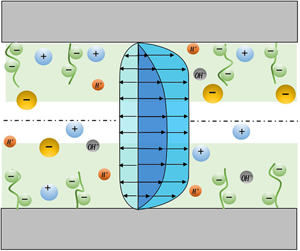Crossref Citations
This article has been cited by the following publications. This list is generated based on data provided by
Crossref.
Chun, Byoungjin
and
Chun, Myung-Suk
2021.
Electrostatic Potential Analysis in Polyelectrolyte Brush-Grafted Microchannels Filled with Polyelectrolyte Dispersion.
Micromachines,
Vol. 12,
Issue. 12,
p.
1475.
Jiang, Weiquan
Zeng, Li
Fu, Xudong
and
Wu, Zi
2022.
Analytical solutions for reactive shear dispersion with boundary adsorption and desorption.
Journal of Fluid Mechanics,
Vol. 947,
Issue. ,
Sivasankar, Vishal Sankar
Prajapati, Mihirkumar
and
Das, Siddhartha
2022.
Analytical solutions for nonionic and ionic diffusio-osmotic transport at soft and porous interfaces.
Physics of Fluids,
Vol. 34,
Issue. 2,
Zhang, Wenyao
Farhan, Muhammad
Jiao, Kai
Qian, Fang
Guo, Panpan
Wang, Qiuwang
Yang, Charles Chun
and
Zhao, Cunlu
2022.
Simultaneous thermoosmotic and thermoelectric responses in nanoconfined electrolyte solutions: Effects of nanopore structures and membrane properties.
Journal of Colloid and Interface Science,
Vol. 618,
Issue. ,
p.
333.
Sin, Jun-Sik
2022.
Structural and electrostatic properties between pH-responsive polyelectrolyte brushes studied by augmented strong stretching theory.
The Journal of Chemical Physics,
Vol. 157,
Issue. 8,
Seo, Dongwoo
Kim, Dongjun
Seo, Sangjin
Park, Jungyul
and
Kim, Taesung
2023.
Analyses of Pore-Size-Dependent Ionic Transport in Nanopores in the Presence of Concentration and Temperature Gradients.
ACS Applied Materials & Interfaces,
Vol. 15,
Issue. 1,
p.
2409.
Pandey, Doyel
and
Hardt, Steffen
2023.
Thermo-osmotic flow in slit channels with boundary slip: giant flow amplification between polarized graphene surfaces.
Journal of Fluid Mechanics,
Vol. 967,
Issue. ,
Heydari, Amirhossein
Khatibi, Mahdi
and
Ashrafizadeh, Seyed Nezameddin
2023.
Fine-tuning ionic transport through hybrid soft nanochannels: The role of polyelectrolyte charge density distribution.
Physics of Fluids,
Vol. 35,
Issue. 8,
Mehta, Sumit Kumar
and
Mondal, Pranab Kumar
2023.
Influence of viscoelectric effect on diffusioosmotic transport in nanochannel.
ELECTROPHORESIS,
Vol. 44,
Issue. 1-2,
p.
44.
Ishraaq, Raashiq
and
Das, Siddhartha
2024.
All-atom molecular dynamics simulations of polymer and polyelectrolyte brushes.
Chemical Communications,
Vol. 60,
Issue. 48,
p.
6093.
Zhan, Jie
Jiang, Weiquan
and
Wu, Zi
2024.
Reactive transport in open-channel flows with bed adsorption and desorption.
Journal of Hydrology,
Vol. 632,
Issue. ,
p.
130855.
Das, Siddhartha
2025.
Nanocapillary Core-Annular Flows of Immiscible Active and Non-Active Liquids Trigger External-Drive-Free Nanofluidic Liquid Transport.
Langmuir,
Vol. 41,
Issue. 11,
p.
7790.
Smook, Leon A.
Dahlin, Andreas
Schroën, Karin
and
de Beer, Sissi
2025.
Responsive Polyelectrolyte Brushes in Applications: Functions, Stimuli, and Design Considerations.
Advanced Materials,
Vol. 37,
Issue. 42,
Pandey, Doyel
and
Hardt, Steffen
2025.
Contribution of convective transport to thermoelectricity in confined electrolyte solutions.
Physical Review Fluids,
Vol. 10,
Issue. 6,
Liu, Xinxi
Zhang, Wenyao
Jiao, Kai
Wang, Qiuwang
and
Zhao, Cunlu
2025.
Electro-osmotic flow of semi-dilute polyelectrolyte solutions in nanochannels.
Journal of Fluid Mechanics,
Vol. 1013,
Issue. ,
Ferreira Paiva, Lohanna
de Almeida, Odenir
Silingardi, Helena Maura Torezan
and
Novaes, Letícia Rodrigues
2025.
Flight mechanics characteristics of wind-dispersed seeds from Brazilian savanna.
Journal of the Brazilian Society of Mechanical Sciences and Engineering,
Vol. 47,
Issue. 12,
Padhi, Prasenjeet
Mehta, Sumit Kumar
Mondal, Pranab Kumar
and
Wongwises, Somchai
2025.
Towards the characterization of chemiosmotic flow of ionic liquids in charged nanochannels.
Physical Chemistry Chemical Physics,
Vol. 27,
Issue. 17,
p.
8692.
Mehta, Sumit Kumar
Biswas, Gautam
and
Mondal, Pranab Kumar
2025.
Arresting of Viscoelectric Effect Modulated Flow Reduction in Nanochannels with Imposed Temperature Gradients.
Langmuir,
Vol. 41,
Issue. 30,
p.
19754.
Ishraaq, Raashiq
and
Das, Siddhartha
2025.
Linear Discriminant Analysis-Based Machine Learning and All-Atom Molecular Dynamics Simulations for Probing Electro-Osmotic Transport in Cationic-Polyelectrolyte-Brush-Grafted Nanochannels.
The Journal of Physical Chemistry B,
Vol. 129,
Issue. 23,
p.
5854.



